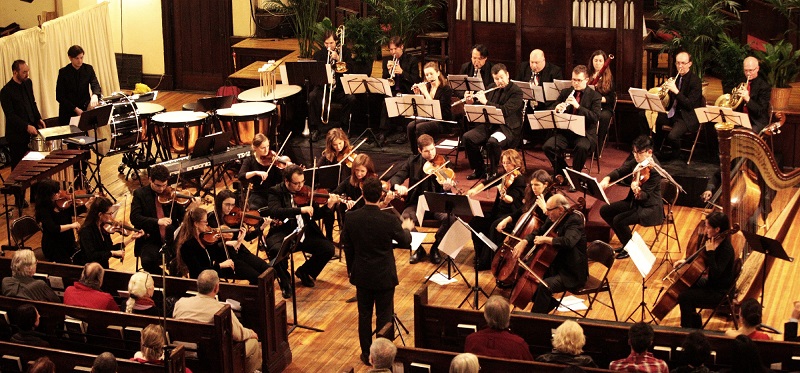Alberto Ginastera was born on April 11, 1916, and it was a hundred years later, on April 11, 2016, that the Spectrum Symphony presented a centennial commemoration of the Argentine composer at the Broadway Presbyterian Church in Manhattan. The wide-ranging and innovative concert wasn’t limited to works and performances by Ginastera or other artists with South and Central American connections. It was, rather, a celebration of broad influence and far flung affinity, generous in scope and presentation.
The Bulgarian pianist Tania Stavreva opened the program with two Ginastera pieces, followed by her own “Bulgarian Prelude,” written as a tribute to the composer. She’s a sensuous, dramatically aware keyboardist, fascinating to watch, in her fingerwork, as well as to hear. She was succeeded by the soprano Ariadne Greif, California-born, who sang five popular song forms by Ginastera. Greif is best, superb, even, with the slower, more soulful genres, a little imprecise with the more quickly paced. The first part concluded with Ginastera’s Concerto for Harp and Orchestra, Op. 25, from 1956, with the French-born harpist Mélanie Genin and David A. Grunberg conducting.
The Concerto defined for me what is great about Ginastera: a sense of something submerged that is in ferment and waiting to emerge. Atop the underlying movement, yet entwined at the root, is the harp, on which Genin delivered the instrumental tour de force of the evening. There’s a pictorial dimension to harp playing greater than with most instruments, and she has the grace and stature to merge visually with it (even from a less-than-ideal vantage). Something in her playing exposes, in turn, the geometry of the sound: you hear in the notes the curvature of the instrument. Grunberg and his musicians delivered a fitting tribute, with hints of landscape and folk culture in its ebbs and flows, and that something, neither positive or negative, indeterminate, but of great power, that finally breaks through.
The concert was ingeniously structured, its first part providing for a web of associations, musical and thematic, to emerge in the second. Grunberg returned from intermission with an unannounced performance of Piazzolla’s “Libertango,” which wove tango and the idea of liberation into the texture. With that, the concert shifted to two orchestral premieres by Sergio R. Reyes, a Guatemalan well known in New York as a tango violinist. Each is rooted in milonga, a sister genre to tango, and, like the concert as a whole, a homage. But to figures other than Ginastera: the murdered activists Berta Cáceres (Honduras) and Rigoberto Lima (Guatemala), and Octavio Brunetti, the beloved tango pianist who died young and suddenly in 2014. The Honduran-American actor, organizer, and personality Walter Krochmal set the scene, his voice resonant in the hall, with accounts of the murdered activists and appeals to the broader losses, cultural and environmental, they sought to prevent.
The pieces, back to back, were a study in unity through contrast, the first recalling what we think of as the natural world, the second, streets and urban life. The music emerges from the environment that it calls to mind, rather than imposing itself upon it, an analog of the values, in activism and art, that it celebrates. “A los guardianes del rio” (For the Guardians of the River) could be walked in on from the street and spark images of water and the land; milonga is submerged in its contours like a rhythm of nature, returned to its source. In “El encanto de Buenos Aires/ El Enfermero” (The Charm of Buenos Aires/ The Nurse), dedicated to Brunetti, the form is more apparent; one hears the step, here and there, of a foot on cobblestone, the walk stirring itself to dance. Tango grew, at least partly, out of milonga, a transition captured, subtly, in the progress of the work. Reyes’ compositions accomplish, in succession, a music of homage and healing, of looking back with a way to move forward, of the land and the city at once.
The concert shifted, to conclude, back to Ginastera, and his twelve part Variaciones Concertantes for chamber orchestra, Op. 23, a work of infinite mood, genuinely varied in its pleasures and aesthetic challenges. It summed up what, I thought, was the theme of the night: the struggle to emerge and the desire to return. It is there in tango, in orchestral structure, in liberation and resistance.
For more on the Spectrum Symphony, click here. Event photo by Chip Tilden.

One response to “Alberto Ginastera”
[…] first sight and sound of Tania Stavreva was at a tribute to the Argentine composer Alberto Ginastera in his centennial year. The Bulgarian-born pianist opened the concert, to great effect, with two […]